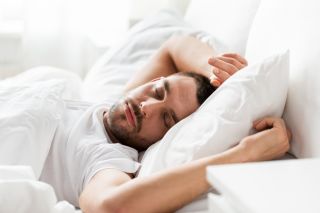Sleep
6 Lesser-Known Ways to Get Better Sleep
Hopefully, the most practical sleep article you'll ever read.
Posted August 30, 2021 Reviewed by Devon Frye
Key points
- Perfect sleep hygiene is sometimes too hard.
- You can improve your self-hygiene without giving up activities you like.
- There are alternatives to giving up electronics and all caffeine.

You've no doubt heard many of the standard tips for what you should do if you can't sleep. Collectively, these are often termed sleep hygiene. The most commonly mentioned suggestions include:
- stop consuming caffeine
- have a consistent wind-down routine for before you go to bed
- don't use your bedroom for anything other than sleep and sex
- don't use any devices in the hours just before bed
That's all well and good. But what if you can't get yourself to do those things? What if you don't want to do those things?
What If Sleep Hygiene Is Too Hard?
If you've heard those recommendations before and just blown them off, no judgment here. Try these more achievable suggestions. It's OK if not all of these appeal. Start with one or two that feel genuinely achievable and appealing to you.
1. Dim, red light.
Most nights before I go to sleep, I watch YouTube on my phone in bed. However, I have my phone in night mode (so less blue light comes from the phone.) I also use a color-changing lightbulb in my bedroom. When I'm winding down to go to sleep, I switch it to low brightness and a dark red color. Why red? Red light mimics sunset. Switching the color is a strong visual cue. My brain associates it with getting ready for sleep. It's an easy wind-down routine.
2. Expose yourself to bright sunlight in the mornings.
My spouse recently asked me why I'd been going to bed earlier. I had to think about it. Then I realized what the change was. Recently, I purchased a cooling vest (a vest with pockets for ice packs), so I can walk outside in hotter weather. Since I got it, I've been going for walks as soon as I get up.
Light sets your circadian rhythms—the times you naturally want to wake up and go to sleep. I live in the desert where it is very bright. Exposing myself to so much bright light early in my day had shifted my rhythms earlier, without me having to try to go to sleep earlier.
This pattern becomes self-perpetuating. The earlier you feel ready for sleep, the earlier you'll wake up, and the more interested you'll be in a morning walk.
Whatever you usually do in the mornings, try switching to walking outside as soon as you wake up. Have breakfast, your shower, and do whatever else you currently do either later in the day or skip it.
3. Focus on an earlier point in your evening.
When people struggle to sleep, they often develop anticipatory stress about getting to sleep. You might think, "Will I get to sleep tonight? Will I end up lying in bed with my mind going 100 miles an hour, feeling agitated?"
Instead of over-focusing on what you do right before bed, think about a point earlier in the evening. For example, preparing dinner or getting your children to sleep. Try to establish a better routine for that earlier part of your evening. Many people need a few hours of relaxation between when they finish their responsibilities for the night and when they go to sleep. If you're better organized about whatever happens early in your night, you'll be ready for sleep earlier.
Pro tip: Any routine you set at any point of your day will typically flow onto better routines later in the day.
4. Switch your last caffeinated beverage of the day to half-caf or no caf.
With psychology advice, think: good, better, best.
The way to get the best sleep would be to consume no caffeine and no alcohol. Both disrupt sleep. If you want to sleep like you did as a teenager, completely ditching caffeine might get you there.
However, ask yourself, "What's the best thing I'm willing to do?" Perhaps you say, "I'm not willing to change my caffeine consumption." But there might be something you're willing to do, like drinking a caffeine-free soda for your last soda of the day. Or, having a half-caf/half-decaf coffee for your last coffee of the day.
If you want to experiment with going caffeine-free, there are ways to do without brutal caffeine withdrawal. About 20 months ago, I switched from caffeinated to caffeine-free soda. I did it by taking a swig out of a bottle of caffeinated soda, and then pouring in caffeine-free soda to fill up the bottle. Every time I would take a drink out of the bottle, I would pour in more caffeine-free sofa, to continually dilute the caffeine content. Within 7-10 days, I moved completely to caffeine-free. It was never intended as a permanent change, but so far I haven't gone back. Lately, I've been drinking more electrolyte water and less soda.
5. Find content that only requires listening, not watching.
If you struggle with worry or rumination, you may find that entertainment helps you get to sleep. Standard suggestions are to listen to an audiobook, a meditation, or relaxing sleep sounds (like sounds of rain or a crackling fire). However, lots of video content doesn't actually require watching it. Pick comforting topics—not anything about the news, the pandemic, or business. Don't pick anything that is focused on you doing something, like DIY or self-improvement. For example, you could pick videos or podcasts that discuss TV shows. Find content you like to listen to only.
6. Take to-dos off your mind.
If you find yourself thinking "I need to remember to do X in the morning," try to take that off your mind. For example, if there is something you need to take with you, put it in your car or at your front door so that forgetting it will be impossible. Take anything you need to remember off your mind.
Of course, we could all practice perfect sleep hygiene. But most people who know about good sleep hygiene buck that in some ways, and still choose to use their phones or TVs in the evenings. If you can't do what's ideal—or don't want to—try these suggestions instead. If you can't do what's best, do what's good—or at least good-ish!
LinkedIn image: Monkey Business Images/Shutterstock. Facebook image: Syda Productions/Shutterstock




